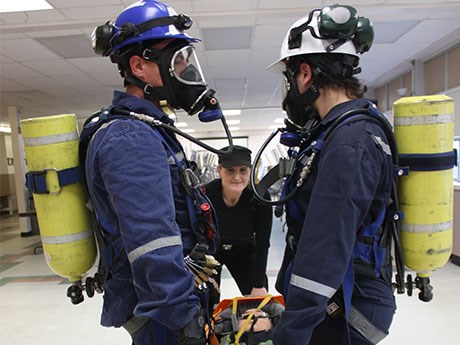Regulations governing work in confined spaces tightened in response to fatalities at Ontario steel mill
During a mine shutdown, there could be 20 to 60 teams mobilized to ensure the safety of workers in confined spaces.
Significant changes were made in 2006 to the Ontario Ministry of Labour’s Confined Spaces regulation under the Occupational Health and Safety Act after recommendations were made by a coroner’s inquest investigating the death of two workers in 1997 at a Hamilton steel mill. One worker was clearing debris from a three-storey degasser tank and collapsed. The second worker was a safety attendant who went in to help and also suffocated.
The regulation defines a confined space as one not designed or constructed for continuous human occupancy and in which atmospheric hazards may occur because of its construction, location or contents, or because of work that is done in it.
It further defines a hazardous atmosphere as one in which there is the possibility of an accumulation of flammable, combustible or explosive agents, one that has an oxygen content that is less than 19.5 per cent or more than 23 per cent, or one where atmospheric contaminants could result in acute health effects that pose an immediate threat to life or interfere with a person’s ability to escape unaided.
Examples of confined spaces in mining include tunnels, ore bins, furnaces, storage tanks and processing vats. Often, what makes these confined spaces a health and safety risk is the potential presence of toxins, which are not always detected until assessed and often change radically in short periods of time.
Unprotected exposure to toxins can cause asphyxiation or irritation to skin, eyes and the respiratory system.
Seeing the need for trained safety workers, Marc Gingras started Confined Space Management (CSM) to supply qualified safety teams to mining companies. The business is thriving and growing after only a year in operation
Gingras is a millwright by trade and has operated G.J. Mechanical Ltd. in Verner, 73 kilometres east of Sudbury, for 20 years. He is very familiar with working in confined spaces, the risks associated with them and the safety measures required.
“Mining companies can spend a lot of their budget on safety for work in confined spaces,” said Gingras. “Some have their own teams. However, if they don’t have enough employees to pull off regular positions, then we are one of the best solutions.”
CSM offers a full package of quality control, which is achieved by following and going beyond the guidelines of the regulations.
Steps
There are a number of steps that employers must follow to create a confined space program. They have to develop a confined space entry plan, conduct a hazard assessment, develop a plan that addresses the hazard assessment, provide adequate training for workers to enter confined spaces, provide permits that set out measures and procedures for work in the confined space and keep detailed records.
Gingras said CSM teams are knowledgeable about the regulations and guidelines. They start with a detailed plan of the work to be performed in the confined space, allowing them to prepare the space inside and out.
When CSM teams arrive at the worksite, they are equipped with atmospheric monitoring equipment, rescue equipment, protective equipment and qualified personnel focused entirely on safety.
“We work towards zero-harm so every worker goes home to their families at the end of the day,” said Gingras. “It starts with the documentation, the program, plans and permits. We ensure that the atmosphere inside the confined space is safe, that there are no injuries while performing the work and those outside are safe as well.”
The CSM teams are all certified in advanced first aid, cardiopulmonary resuscitation, fall protection, patient immobilization and extraction.
Training
“A number of our employees are retired police officers, fire fighters or paramedics,” said Raven Essler, general manager for CSM. “All of our employees receive ongoing training beyond what is mandatory.
CSM has a roster of 30 employees who form teams and attend work sites. Xstrata Nickel is the company’s primary client, however, demand continues to grow across Northern Ontario.
The 2011 amended guidelines for work in confined spaces are available at http://www.labour.gov.on.ca.


